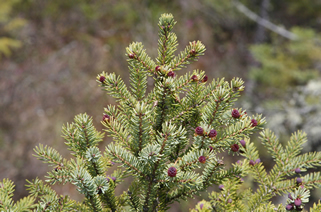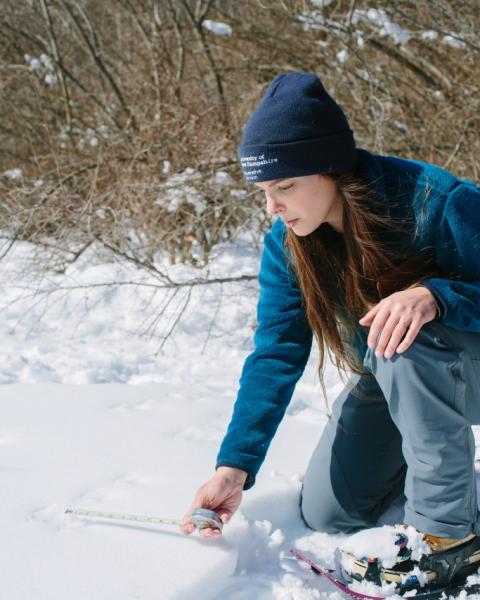Peatlands are wetland ecosystems that contain peat, a spongy, organic material formed by partially decayed wetland plants. Typically found in cool climates, peatlands are associated with acidic or stagnant water this is low in oxygen. The water in many peatlands is highly acidic and lacking in nutrients, creating growing conditions for a very distinct group of plants.
Types of Peatlands
The most common type of peat is “Sphagnum peat,” made up of layers of Sphagnum moss. Sphagnum plants float, and as they grow along the edges of ponds or slow moving streams, they expand onto the surface of the water (see photo at right of at Pondicherry National Wildlife Refuge in Whitefield, NH). As older plants die, new plants grow on top, thickening and strengthening the peat mat, which may eventually cover the entire pond. Visitors to these peatlands may experience the peat mat trembling underfoot as it floats, giving rise to the term “quaking bog.” The peat mat also provides a surface on which other vegetation can grow.
Peatlands can be categorized into three groups:
- Bogs receive very little surface water flow and are among the most acidic peatlands. They are dominated by shrubs such as leatherleaf and bog laurel.
- Fens are peatlands associated with moving water, either along a river or lake, or with a stream that flows into or out of the peatland. Fens range from very acidic (where the plants resemble those found in bogs) to mildly acidic, and are dominated by a combination of sedges and shrubs.
- Peat swamps are peatlands dominated by trees. There are many different types of these forested wetlands, with black spruce and larch swamps common in the northern part of the state, and red maple swamps more common in central and southern New Hampshire.
The NH Natural Heritage Bureau finds, tracks, and helps conserve New Hampshire’s rare plants and exemplary natural communities, many of which are peatlands. Their photo gallery contains many different varieties of peatlands (or "natural community types") in New Hampshire.
Why are Peatlands Important?

Peatlands add significantly to New Hampshire’s biodiversity.
At least 550 different plants grow in peatlands in the state, many of them highly-specialized to their environment. Peatlands also provide habitat for a unique collection of animals, including the ringed boghaunter, a rare dragonfly that breeds in open peatlands in southern New Hampshire. In the north, peat bogs are a favored habitat of bog lemmings and spruce grouse.
Rare and unique species
Peatlands may be most notable for the distinctive plants they support, such as the carnivorous pitcher plant and sundew, or for the variety of colorful orchids that grow there. The New Hampshire Natural Heritage Bureau tracks fifty-four rare plant species that occur in some type of peatland habitat. Many insects found in peatlands depend on a single peatland plant species for food or to complete their life cycle. For example, in the northeast there are four different insects and one mite that depend on pitcher plants for their survival.
Threats to peatlands
Like other wetlands, peatlands are threatened by development (by filling and draining), especially in fast-growing parts of the state. Peatlands are particularly sensitive habitats and are vulnerable to changes in the uplands that surround them. Runoff from agricultural fields, lawns, and commercial irrigation can have significant effects on peatland vegetation. Lime and fertilizer runoff can increase nutrients and can raise the pH (i.e., reduce the acidity) of peatland waters. These changes can increase the rate of decay of peatland soils, potentially destroying the peat mat. Timber harvesting can also significantly alter forested peatlands. If harvesting occurs when soils are not completely frozen and the ground is not snow-covered, equipment can damage or destroy fragile peat soils. Additionally, if a peat swamp undergoes a particularly intensive harvest such as a clearcut, the loss of trees can alter the hydrology of the peatland. This can result in a higher water table, preventing trees from regenerating on the wetter soils and potentially altering the vegetation structure for decades.
Where are Peatlands in New Hampshire?

Peatlands, though rare on the landscape, are scattered across the state. In central and southern New Hampshire, peatlands are often associated with interesting geological features called “kettleholes.” These circular depressions were created by large ice blocks left behind by retreating glaciers and support wetlands called “kettlehole bogs.”
Black spruce (see photo at right) swamps and northern white cedar swamps are unusual wetlands found mostly in the north, while red maple swamps (common) and Atlantic white cedar swamps (rare) occur mostly in the south. Good examples of peatlands include Philbrick-Cricenti Bog in New London, Ponemah Bog in Amherst, and Hurlbert (northern white cedar) Swamp in Stewartstown.
Climate Vulnerabilities for Peatlands
- Increased temperature may result in increased decomposition rates, causing peat mats to decay more rapidly, and resulting in a loss of peatland habitat, and possible conversion to marsh
- Extended periods of drought may further promote increased decomposition.
Click here for the Peatlands Climate Assessment, a section of the Ecosystems and Wildlife Climate Change Adaptation Plan (2013), an Amendment to the NH Wildlife Action Plan
Wildlife Found in Peatlands
Many wildlife species use peatlands for part of their life cycle, whether for breeding, feeding, cover or nesting. Below are some examples of species that depend on peatland habitats. Be on the lookout for these species and other wildlife associated with peatlands. Follow stewardship guidelines to help maintain or enhance peatlands. Species of conservation concern--those wildlife species identified in the NH Wildlife Action Plan as having the greatest need of conservation--appear in bold typeface and are linked to their wildlife profile from the Plan.
- Blanding's turtle**
- Eastern towhee
- Mink frog
- Southern bog lemming
- Northern bog lemming
- Palm warbler
- Ribbon snake
- Ringed boghaunter dragonfly**
- Rusty blackbird
- Spotted turtle*
- Spruce grouse
* state-threatened species, ** state-endangered species
Stewardship Guidelines for Peatlands

- Peatlands are very vulnerable to changes in water flow and the level of the water table. Damming of streams flowing in or out of a peatland will change water level patterns and can lead to damage to the peat mat and changes in vegetation.
- Although most peatlands are not traditional waterfowl habitat, they are unique habitats in their own right for a wide variety of animals and plants. Peatland communities should not be excavated to create open water areas for waterfowl.
- Don’t use heavy machinery on peatland soils to avoid negative impacts to plant and animal species or disruption of the wetland’s hydrology through rutting or soil compaction.
- Maintain brush and other woody material in and around peatlands to provide cover for small mammals, amphibians, and reptiles.
- Avoid repeated trampling of peatland vegetation. ATVs and other off-highway recreation vehicles (OHRVs) should not be allowed in or around peatlands. Trails for these vehicles should be located at least 100 feet from any peatland to deter drivers from entering.
- At popular peatland destinations, walking access for the public should be on raised boardwalks to protect peatland soils and vegetation. Some wildlife species live in the Sphagnum and are sensitive to repeated trampling, including bog lemmings and boghaunter larvae.
- Avoid public access near rare plants, especially orchids. Collectors can decimate populations. Insects that depend on the bog plants will therefore lose their habitat.
- New Hampshire Fish and Game tracks all sightings of rare animals. If you have information about a wildlife species of conservation concern (or want to learn more), contact NH Fish & Game’s Wildlife Division at 603-271-2461.
- For land conservation efforts to successfully protect peatland wildlife, uplands surrounding peatlands need to be protected as well. A 300 foot buffer of upland, undisturbed by human development or agriculture, protects water resources and habitat for many species.
- Timber harvesting in peatlands should be limited to selection, thinning, or some other partial harvest, and restricted to periods of frozen ground and snow cover.
- Always consult a licensed New Hampshire forester before conducting at timber harvest on your property. Understand and follow all laws pertaining to the harvesting of trees near wetlands and peatlands. Follow established Best Management Practices, and harvest timber near wetlands only when the soils are either frozen (winter) or very dry (summer).
More Resources for Peatlands
- NH Natural Heritage Bureau - this bureau of the NH Division of Forests & Lands finds, tracks, and helps conserve New Hampshire’s rare plants and exemplary natural communities, many of which are peatlands. Visiting NH’s Biodiversity has brochures, profiles and photos of many of New Hampshire’s most unique and pristine peatlands.
- NH Wildlife Action Plan habitat profile for Peatlands - information about the condition and location of peatlands, threats, and conservation actions needed to protect peatlands in New Hampshire.
- Habitat Stewardship Brochure on Peatlands - Contents of this webpage are also available in hardcopy and .PDF versions: paper copies to order, or download and print PDF.
The contents of this webpage are also available in the following formats:
- Brochure - hard copies available by order
- PDF - for download or printing
Dowload Resource for printable version.
Photo Credits on this page: Emma Carcagno; Ben Kimball (Nat. Heritage Bureau); Phil Brown (NH Audubon)
Research for this webpage and accompanying Habitat Stewardship brochures was conducted by UNH Cooperative Extension staff with support from the Sustainable Forestry Initiative and NH Fish & Game
